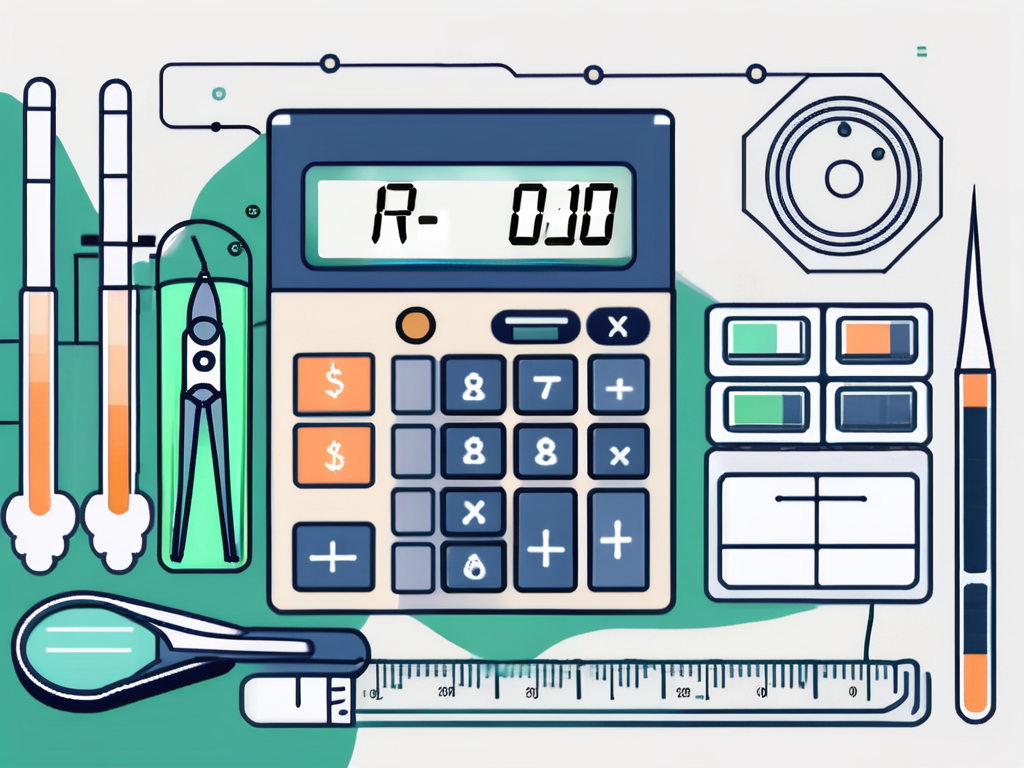Unlock the secrets of R&D tax credit calculation with our comprehensive guide.
rEAD MORE
In today's competitive business landscape, companies are constantly striving to push the boundaries of innovation and stay ahead of the curve. Research and development (R&D) plays a crucial role in this pursuit, driving advancements and breakthroughs that benefit both businesses and society as a whole. To incentivize and support companies in their R&D efforts, governments around the world offer R&D tax credits. These tax credits are designed to encourage innovation by providing financial relief and incentives for companies engaged in qualifying research activities.
In order to fully grasp the intricacies of R&D tax credit calculation, it's essential to have a clear understanding of what R&D tax credit entails. At its core, R&D tax credit is a tax incentive provided by governments to support and promote research and development activities undertaken by eligible businesses. This tax credit serves as a means to reduce a company's tax liability, thereby freeing up resources that can be reinvested back into R&D initiatives.

Furthermore, R&D tax credits are designed to incentivize companies to push the boundaries of innovation and invest in cutting-edge technologies. By rewarding businesses for their efforts in research and development, governments aim to create a competitive environment that drives progress and fosters growth across various industries.
R&D tax credit is a government-sponsored tax incentive that aims to encourage businesses to invest in innovative research and development activities. It provides companies with a financial cushion in the form of tax relief, allowing them to allocate more resources towards R&D projects and technological advancements.
Moreover, R&D tax credits come in various forms, such as a percentage of qualifying R&D expenses or a tax deduction for eligible R&D activities. This flexibility in the structure of R&D tax credits enables businesses of all sizes to leverage this incentive and drive forward their research agendas with financial support from the government.
The importance of R&D tax credits cannot be overstated. They serve as a powerful tool to foster innovation, boost technological advancements, and stimulate economic growth. By reducing the financial burden associated with R&D expenses, companies are empowered to take risks, explore new ideas, and drive forward groundbreaking innovations that have the potential to revolutionize industries.
Additionally, R&D tax credits play a crucial role in leveling the playing field for businesses, particularly small and medium-sized enterprises, by providing them with the financial means to compete with larger corporations in terms of research and development capabilities. This democratization of innovation through R&D tax credits contributes to a more dynamic and vibrant business landscape, where creativity and ingenuity thrive.
While the benefits of R&D tax credits are undoubtedly enticing, it's crucial for businesses to understand the eligibility criteria in order to maximize their chances of claiming these credits. Fulfilling the eligibility requirements ensures that companies can fully leverage the opportunities and financial benefits offered by R&D tax credits.

When it comes to claiming R&D tax credits, it's essential for businesses to not only focus on the potential financial gains but also on the innovative and technological advancements that can result from such investments. By meeting the eligibility criteria, companies can not only benefit financially but also contribute to the overall growth and development of their industries.
In order to claim R&D tax credits, companies must engage in research activities that satisfy certain criteria. These criteria typically include activities that involve the development of new products, processes, or services, as well as projects aimed at improving existing products or processes.
Furthermore, qualifying research activities can encompass a wide range of fields, from biotechnology and pharmaceuticals to software development and engineering. By exploring diverse research avenues, businesses can not only increase their chances of eligibility for R&D tax credits but also foster a culture of innovation within their organizations.
Aside from engaging in qualifying research activities, companies must also meet certain expenditure requirements to be eligible for R&D tax credits. These requirements usually include expenses related to wages, supplies, and contract research. It's crucial for businesses to maintain accurate and detailed records of their expenses to ensure compliance and maximize their tax credit claims.
Moreover, investing in research and development not only benefits individual companies but also contributes to the overall economic growth of a nation. By incentivizing innovation through R&D tax credits, governments aim to stimulate technological progress, create high-skilled jobs, and enhance global competitiveness. Therefore, meeting the eligibility criteria for R&D tax credits is not only advantageous for businesses but also plays a vital role in driving societal progress and prosperity.
Calculating R&D tax credits can be a complex process, requiring meticulous attention to detail and a thorough understanding of the various components involved. To simplify this process, it's important to break it down into several key steps, each contributing to the overall calculation of the tax credit amount.

Research and Development (R&D) tax credits are a valuable incentive provided by the government to encourage innovation and technological advancement. By offering tax credits to companies engaged in qualified research activities, the government aims to stimulate economic growth and competitiveness in various industries.
The first step in calculating R&D tax credits is to identify and categorize qualified research expenses (QREs). These expenses include wages paid to employees directly involved in research, expenses related to supplies and materials used in research, and certain contract research expenses.
It's crucial to keep detailed records of all expenses related to R&D activities to ensure accurate identification of QREs. Proper documentation not only simplifies the calculation process but also serves as evidence in case of an audit by tax authorities.
The next step involves applying the four-part test, which serves as the foundation for determining whether a particular activity qualifies for R&D tax credits or not. This test evaluates the purpose, process, uncertainty, and technological nature of the research activity, ensuring that it meets the necessary criteria.
Each component of the four-part test plays a crucial role in assessing the eligibility of R&D activities for tax credits. Companies need to demonstrate not only the technical challenges involved in their research but also the systematic approach taken to address those challenges.
Once the qualified research expenses have been identified, and the four-part test has been applied, the final step is to calculate the actual tax credit amount. This involves determining the eligible percentage of qualified research expenses and applying it to the total amount spent on R&D activities.
Companies should regularly review and update their R&D tax credit calculations to reflect any changes in expenses or activities that may impact the final credit amount. By staying informed about the latest regulations and guidelines related to R&D tax credits, companies can maximize their tax savings and reinvest those funds back into innovation and research.
While claiming R&D tax credits can provide numerous benefits, it's crucial to be aware of common pitfalls and mistakes that could potentially hinder the calculation process and reduce the claimed amount. Avoiding these mistakes ensures that businesses can fully capitalize on the opportunities offered by R&D tax credits.
Understanding the intricacies of R&D tax credit calculation is essential for maximizing the benefits that can be derived from this incentive. By delving deeper into the nuances of the calculation process, businesses can uncover additional opportunities to claim credits and optimize their tax savings.
One common mistake is overlooking indirect expenses that can be claimed as part of R&D tax credits. Indirect expenses such as overhead costs and administrative expenses should not be neglected, as they can significantly impact the overall tax credit amount.
Exploring the full scope of indirect expenses related to research and development activities can reveal hidden opportunities for claiming tax credits. By meticulously documenting and including all relevant indirect expenses in the calculation, businesses can ensure that they are maximizing their potential tax savings.
Another mistake to avoid is misclassifying research activities. It's important to accurately categorize and document research activities to ensure they meet the necessary criteria for R&D tax credit qualification. Misclassifying activities can lead to missed opportunities and potential complications during the claims process.
By conducting a thorough review of research activities and consulting with experts if needed, businesses can avoid misclassification errors and ensure that they are claiming all eligible activities for R&D tax credits. This attention to detail can streamline the claims process and maximize the tax benefits that can be obtained.
While following the proper procedures for calculating R&D tax credits is essential, there are additional steps businesses can take to maximize their tax credit claims and fully leverage the benefits offered by this incentive.
One key strategy to maximize R&D tax credits is to establish a dedicated team or department focused on research and development activities. By creating a culture that prioritizes innovation and encourages experimentation, companies can foster a more robust R&D environment, leading to increased qualifying activities for tax credit claims.
A proactive approach to strategic planning for R&D activities can significantly enhance the eligibility and effectiveness of R&D tax credit claims. By aligning research projects with business goals, identifying potential areas of innovation, and documenting all relevant activities, companies can increase the overall impact of their R&D efforts.
Furthermore, collaborating with external partners such as universities, research institutions, or industry experts can bring fresh perspectives and specialized knowledge to R&D projects. These partnerships not only enrich the research process but also demonstrate a commitment to driving innovation, which can strengthen the case for R&D tax credit claims.
The importance of proper documentation and record keeping cannot be stressed enough when it comes to R&D tax credit claims. Maintaining detailed records of research activities, expenses, and supporting documents not only ensures compliance but also provides a strong foundation for successful claims and potential audits.
In addition to documenting R&D activities, companies should also invest in training programs for employees involved in research projects. Ensuring that staff members understand the requirements for qualifying R&D activities and the importance of accurate record-keeping can streamline the claim process and minimize the risk of errors or omissions.
Given the complexity and intricacies involved in calculating R&D tax credits, many businesses opt to seek the assistance of tax professionals. These professionals play a vital role in navigating the legal and financial aspects of R&D tax credit calculation and claims.
Furthermore, tax professionals bring a wealth of experience and knowledge to the table, having dealt with a myriad of R&D tax credit cases across various industries. Their expertise allows them to identify opportunities for tax savings and ensure that businesses fully leverage the benefits available to them.
Consulting a tax professional is recommended when businesses encounter challenges or uncertainties during the R&D tax credit calculation process. An experienced tax professional can provide valuable guidance, ensuring compliance and accuracy in claiming R&D tax credits.
Moreover, tax professionals can offer proactive advice on structuring R&D activities and expenses to optimize tax credit outcomes. By involving a tax professional early in the process, businesses can strategically plan their R&D initiatives to maximize tax savings and minimize potential risks.
The benefits of hiring a tax professional extend beyond their expertise in R&D tax credits. These professionals can provide strategic advice, assist in maximizing eligible expenses, and effectively communicate with tax authorities on behalf of the company, streamlining the claims process and increasing the likelihood of a successful outcome.
Additionally, tax professionals can conduct thorough reviews of past R&D activities to identify any overlooked opportunities for tax credits. By conducting retrospective analyses, businesses can potentially recover unclaimed R&D tax credits from previous years, providing a valuable source of additional funds for future innovation and growth.
In an ever-evolving landscape, it's critical to keep a close eye on the future of R&D tax credits. Policy changes and technological advancements can significantly impact the availability and effectiveness of these incentives, necessitating constant adaptation and awareness.
Governments continue to monitor and evaluate the effectiveness of R&D tax credit programs. This means that legislation and eligibility criteria could change in the future. Staying informed and proactive allows businesses to adjust their strategies and ensure they continue to benefit from R&D tax credits.
For example, recent discussions among policymakers have centered around expanding the scope of eligible activities for R&D tax credits. This could mean that businesses engaged in cutting-edge research in fields such as artificial intelligence, blockchain, or biotechnology might be able to claim tax credits for their innovative efforts. By keeping abreast of legislative developments and engaging in industry advocacy, businesses can actively shape the future of R&D tax credits.
Advancements in technology have the potential to revolutionize the R&D landscape and subsequently impact the calculation and eligibility criteria for R&D tax credits. Embracing emerging technologies and understanding their implications ensures that companies remain at the forefront of innovation and can take full advantage of the available tax incentives.
One area where technological advancements are already making waves is in the realm of data analytics. With the increasing availability of big data and sophisticated analytics tools, businesses now have the ability to extract valuable insights from vast amounts of information. This has opened up new avenues for R&D, as companies can leverage data-driven research to develop innovative solutions and improve their products or services. As a result, governments may consider incorporating data-driven R&D activities into the eligibility criteria for tax credits, recognizing the importance of this emerging field.
Furthermore, advancements in automation and robotics are transforming industries across the globe. As businesses adopt these technologies to streamline their operations and enhance productivity, they are also engaging in R&D efforts to further refine and improve these systems. Governments may recognize the significance of these advancements and provide additional incentives for businesses involved in developing and implementing automation and robotics technologies.
As businesses strive to stay competitive and innovative, understanding the ins and outs of R&D tax credit calculation becomes paramount. By grasping the fundamental concepts, adhering to eligibility criteria, avoiding common mistakes, and leveraging the expertise of tax professionals, businesses can navigate the complexities of R&D tax credit calculation and unlock the full potential of their innovative efforts. With the future of R&D tax credits evolving alongside technological advancements, proactive adaptation and vigilance are essential to ensuring continued success in this ever-evolving landscape.
Copyright © 2025 Vincere Tax| All Rights Reserved
Privacy Policy